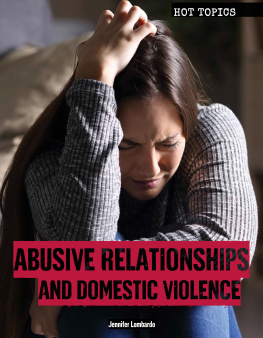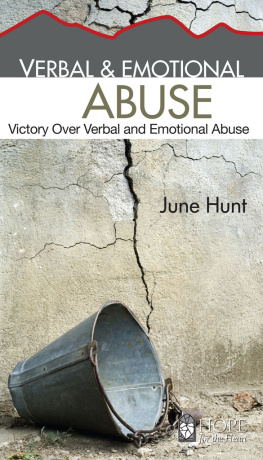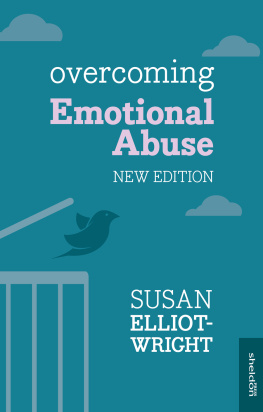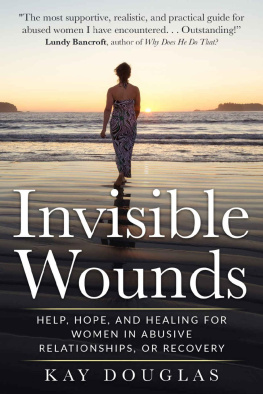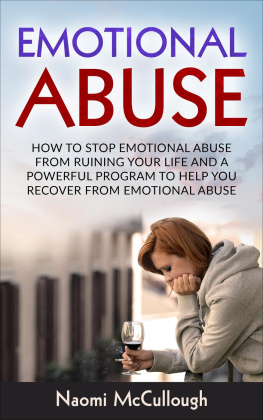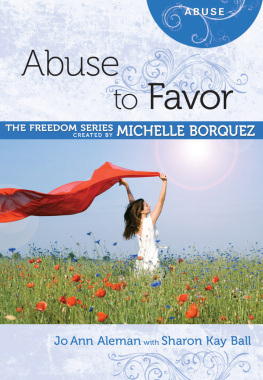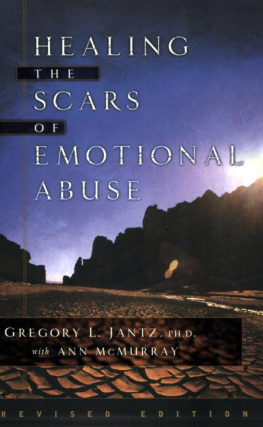How to Stop Being Abused and How to Stop Abusing
Beverly Engel
JOHN WILEY & SONS, INC.



My deepest gratitude goes to Tom Miller-my editor at John Wiley & Sons-who has steadfastly supported all my book ideas. Thank you for your vision, your patience, your faith in me, and your expert editing.
My heartfelt appreciation also goes to my wonderful agents, Stedman Mays and Mary Tahan who work tirelessly on my behalf. Thank you for all you do for me and for being people of such integrity.
Thank you as well to all those who shared their stories with me. Your willingness to share your pain and your triumphs will no doubt help many people.
Much appreciation also goes to all my clients. I have learned a great deal from working with all of you and this knowledge is reflected in my writing.
Finally, while much of my knowledge of Borderline Personality Disorder and Narcissistic Personality Disorder came from my experience working with clients who suffer from these disorders, professional workshops, such as those led by Dr. James Masterson, helped me tremendously. Books such as Trapped in the Mirror: Adult Children of Narcissists in Their Struggle for Self by Elan Golumb, Ph.D.; Lost in the Mirror: An Inside Look at Borderline Personality Disorder by Richard A.Moskovitz, M.D.; and Stop Walking on Eggshells: Taking Your Life Back When Someone You Care About Has Borderline Personality Disorder by Paul T.Mason, M.S. and Randi Kreger added still further to my growing understanding of these disorders.

I wrote this book for several important reasons. First of all, evidence is mounting that emotional abuse is a major epidemic in our culture. At the same time, emotional abuse is the least understood form of abuse. Unlike sexual abuse and domestic violence, there has been very little public education on the subject. Very few people know what constitutes emotional abuse and even fewer understand the consequences of it. Although the number of people who suffer from emotional abuse as children and who either become emotionally abusive themselves as adults or become involved with partners who emotionally abuse them is phenomenal, few people are cognizant of how this form of abuse has deeply affected their lives.
Second, I have a deep and abiding desire to help end the cycle of abuse that characterizes our nation and many others. My hope is that by helping individuals and couples to stop abusing each other, we will raise children who are less likely to pass on abusive communication and behavior to their children and substantially reduce the incidence of child abuse in the future. I have been an advocate for those who have been emotionally, sexually, or physically abused for most of my career as a psychotherapist and an author. My dedication to helping those who have been abused comes from the fact that I myself was emotionally and sexually abused as a child. Many of you reading this book may know me from one or more of my previous books on abuse, especially The Emotionally Abused Woman, Encouragements for the Emotionally Abused Woman, and The Right to Innocence, in which I shared some of my own story.
Third, in the ten years since I wrote The Emotionally Abused Woman and Encouragements for the Emotionally Abused Woman, I have learned a great deal more about the subject, mostly from my continuing work with those who have been emotionally abused. My thinking has changed somewhat from the time I first wrote about emotional abuse, especially concerning the types of people who emotionally abuse their partners. Ten years ago, I, like many authors who have written on the subject of abuse, characterized emotional abusers as monsters beyond redemption. But since that time I have continued to work with those who have become abusive and have gained a great deal of insight and empathy for them. What I have found is that many do not deliberately set out to control, manipulate, or destroy their partners and that most were either emotionally, physically, or sexually abused themselves as children. While books on the subject offer information and strategies to help victims of abuse, few, if any, offer help to partners who become abusive. It is my belief that if we are ever going to stop the cycle of abuse, we must begin to focus on helping the abuser as well as the victim.
Over the years, many women who have read my previous books on the subject have asked me to recommend books for their partners, especially those whose partners have acknowledged their abusive behavior. Unfortunately, it has been difficult to do so. It is my hope that this book will fill the gap and that the information I offer will help men and women who are willing to work toward change.
Another difference between this book and those written by other authors is that I do not assume that the abuser is a male and the victim is a female. While this is still primarily the case when it comes to physical abuse, more and more I am discovering that there are many females who emotionally abuse and many males who are the victims of emotional abuse. Both of these groups of people need help. Females who abuse are often completely unaware that their behavior is harming their partner or damaging their relationship. Males are often unaware that they are being abused or unwilling to admit it out of fear of being ridiculed by others and accused of being less than a man for putting up with it. Nor do I make the assumption that only heterosexual couples suffer from this problem. Gay men, lesbians, and bisexuals all experience emotional abuse in their relationships.
The Emotionally Abusive Relationship will also offer muchneeded help to couples who have slipped into a mutually unhealthy style of interacting with one another. I focus a great deal on the dynamics of an emotionally abusive relationship and how partners can work together to resolve their issues. I offer help to both partners and offer strategies to help them work together to stop the emotional abuse in their relationship.
Since I wrote The Emotionally Abused Woman I have also discovered that there are a large number of people who are in emotionally abusive relationships because one or both partners have Borderline Personality Disorder (BPD). Some of the primary symptoms of this disorder are frequent emotional outbursts, radical mood swings, unreasonable expectations, and a tendency to blame one's partner for one's own problems-all forms of emotional abuse. The Emotionally Abusive Relationship will include information on Borderline Personality Disorder and its effects, as well as a section offering partners of borderline individuals strategies for dealing with the types of emotional abuse they are likely to experience.
Up to ten million North Americans suffer from Borderline Personality Disorder, which seems to occur to a slightly higher degree among gay men and lesbian women. My hope is that the book will also be of interest to those who suffer from this debilitating disorder since many people with BPD feel confused and ashamed by their own behavior. Those who are aware that they have become abusive to their partner and/or children will grow to understand themselves and their behavior better, and this will hopefully help them to work past the stigma of being an abuser. While there are now many books on the subject of BPD, few, if any, address the issue of how to overcome emotional abuse.



